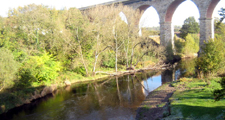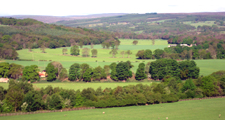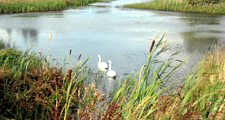Coalfield Valley Floodplain
Land Management
Natural Features, Watercourses and Wetlands
- Protect, and conserve the natural character of, watercourses and wetlands.
- Restore natural conditions to floodplains where possible as part of integrated flood storage and landscape restoration schemes.
- Fence rivers, streams and wetlands against livestock to prevent erosion and allow regeneration of bank-side vegetation.
- Create reed beds (using Common Reed or Great Reedmace) to condition mine water or sewerage discharges.
- Protect ponds from drainage or infilling. Restore former ponds and create new ponds on suitable sites taking ecological advice.
Trees, Woodlands and Forestry
- Conserve and extend the broadleaved woodlands of river banks and floodplain bluffs. Progressively remove non-native species like sycamore and beech from modified ancient woodlands. Restock or extend using natural regeneration or planting native species of local origins.
- Plant new native oak woods in denes and ravines and along steep riverside bluffs. Plant new native alder woods on river banks and streamsides and on wet or seasonally flooded haughs.
- Protect and maintain existing tree lines along watercourses, ditches and river terraces.
Farmland
- Maintain and enhance wet pastures by adopting appropriate stocking levels and avoiding improvements such as drainage, ploughing and reseeding. Limit the use of fertilisers and herbicides.
- Restore former wet pastures by reversion from arable or diversification of improved pastures by drain blocking and reseeding with seed or hay crops from local sources.
- Create grassland or woodland buffers between arable fields and watercourses or wetlands.
Cultural Features
- Protect and conserve relic features like old water mills, forges, mill races and water leats. Avoid physical damage, demolition or infilling. Consolidate important structures taking archaeological advice.
- Protect old gravel workings and manage to maximise their biodiversity value.
Field Boundaries
- Protect, restore and maintain existing hedgerows. Renovate overgrown and gappy hedges by laying or coppicing and gapping up.
- Reinstate hedges where they have been replaced by fences in areas of long established enclosure.
Development
Agricultural Buildings
- Site new farm buildings close to existing buildings where possible, and reflect their scale, character and materials.
- Reduce the impact of larger modern buildings by careful selection of colour, breaking up mass and planting screening belts of native species.
- Energy, telecommunications and infrastructure
- Screen water treatment works with structure planting of native woodland.
Housing and Economic Development
- Avoid new development on the floodplain.
- Design any essential development so that it doesn’t compromise the natural hydrology of the floodplain.
Minerals and Waste
- Restore floodplain gravel workings to wetland, reed bed, wet woodland and wet grassland habitats.
Tourism and Recreation
- Tourism and recreational development should be undertaken in such a way as to avoid any urbanising influence on the landscape.
- New built development on the floodplain should be avoided.
- Golf course development should seek to conserve and reinforce landscape character by retaining mature landscape features and planting new native woodlands and parkland trees. Avoid prominent locations for built elements like driving ranges and ball-trap fencing – having regard to views from adjacent higher ground. Develop species rich grassland in roughs to increase biodiversity and develop new wetland features.
Further Information
- Description of Coalfield Valley Floodplain Landscape Character
- West Durham Coalfield Strategy



